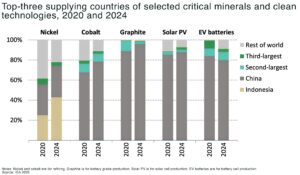The U.S. Department of the Interior is channeling more than $74 million into efforts to map areas that may hold critical mineral resources, aiming to reduce the country’s dependence on foreign suppliers and strengthen domestic supply chains. It’s the latest move by the Biden administration to ramp up growth of domestic critical metal production, including nickel, cobalt and graphite. Funding will support work across 30 states, helping the U.S. Geological Survey (USGS) gather and analyze geoscience data through its Earth Mapping Resources Initiative (Earth MRI). This includes surveying unexplored terrain, reexamining old mine sites, preserving valuable data, and assessing mineral potential in previously overlooked areas like mine waste.
As I’ve mentioned in prior articles, the U.S. is behind the curve on critical metals and has to import most of its needs, while China and Russia hold dominant positions in the global supply chain. In fact, China processes nearly 90% of rare earth elements.
The Department of the Interior has said this is just the start of a long-term effort to better understand what’s underground and put that knowledge to work. Again, I applaud the ambition. However, any country that is serious about domestic critical metal production also needs to take a hard look at their mining codes – particularly blocks to permitting. Until that changes, big battery metal consumers are going to be relying on the output from countries that are all-in on production.
Anthony Milewski
Chairman, Nickel 28 Capital




















